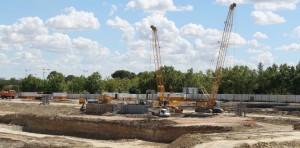
After everything that happened in the real estate from the burst bubble in prices and production houses, few may remember the strong impact that had the approval of the Law of soil (8/2007 and RDL 2/2008). The new regulation was born with the purpose of removing judges of administrative discretion that dictated the appraisals of the soil sometimes objects of expropriation, a phenomenon that, spurred by strong demand in times of boom, it provoked a speculative phenomenon that later had serious repercussions on the accounts and the financial viability of many companies.
Like this, the legislature reduced classes which divided the land historically and established only two types: basic situation of urbanized (Solar) and basic situation of rural (the rest). In this way, If a field which until that moment had State agricultural production had to be expropriated for the construction of a motorway, It should be valued as such (Remember that phrase from the patatal valued as a patatal Minister María Antonia Trujillo) and not on the basis of what was built on the same.
As well, Although the law was born with groundbreaking vocation, the truth is that the crash of the sector and the economy in general, with the suspension of many civil engineering projects, It was what made that they finished in one fell swoop the stratospheric valuations. Last October, adopted the new consolidated text of the law of soil which affects even further this goal of lowering the cost of expropriations and more specifically regulates the conditions of urban land. Regarding the regime of valuations, assumes the judgment of the Constitutional Court of 2014 which was declared null and unconstitutional the maximum of two coefficient setting location factor standard.
This means that the original law it provided that land in rural situation isI could correct the retrieved value capitalization of income from land, by applying a coefficient of a maximum of two, If they were next to urban centers or production centres with specific environmental characteristics, as reminds Andrés Lorente, Director of the floor area of Tinsa. This meant a relief, in the event of an expropriation estimation, for those soils that many developers atesoraron in metropolitan crowns of big cities planning to obtain huge profits and that the standard of 2008 they saw as its value fell to lead.
However, the High Court declared unconstitutional this limit of the ratio of two and argued, as remember Ignacio Ortiz, Analyst's Consultants Forum, that "it was not justified in law nor in the explanatory statement, and could be capricious to avoiding to get the real value of the soil. It considers the Court which may prevent a finding of expropriation compensation commensurate with the idea of the proportional balance and that the limitation is contrary to article 33.3 of the Constitution". That article refers to that "nobody can be private possessions and rights but for cause of public utility or social interest", by means of appropriate compensation and in accordance with the provisions of the laws".
Ortiz explains that, "being a sentence adjusted right, It can produce a rating higher than the real value, falling as well in a speculative phenomenon. The Justice or not will depend on each case and the difference resulting between the calculated value and the actual".
As reminds Andrés Lorente, the method for assessing rural soil consists of dividing the yield of the land (calculated by capitalization of income from land) between a rate of capitalization and its result was applied, in your case, that factor of correction according to the location that you can no longer have the maximum limit of two.
"The determinations set out in the new consolidated text assume higher rates, which means that the values may be significantly lower than that obtained with the previous regulations. If before the internal performance in the secondary market of public debt with a term between two and six years was taken as a reference, Now you consider the average of the last three years of the interest rate of the obligations of the State to 30 years old (3,663%)”, they clarify from Tinsa.
For this reason, as the applicable rates have risen significantly, This results in quite lower estimations of soil. There are cases in which expropriate now with these new rules can bea cost for the administration between five and six times lower that would have been applicable with the legal framework of 2008, insists Lorente.
Read more:
http://www.cincodias.com/cincodias/2016/02/01/economia/1454344950_644466.html